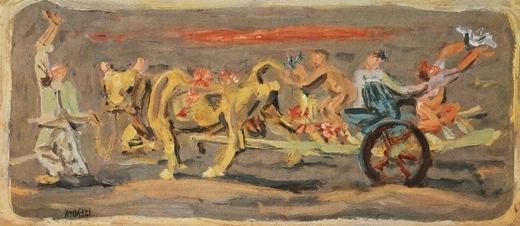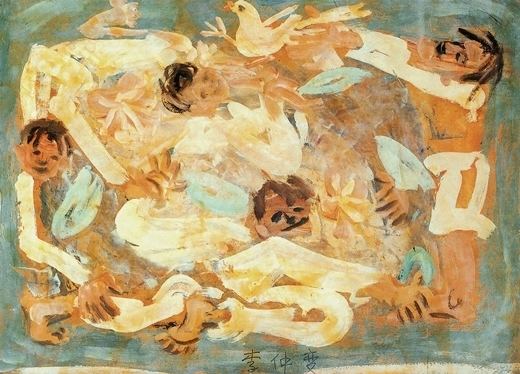Hangul 이중섭 Name Lee Jung-seob McCune–Reischauer Yi chung-sop Spouse Yamamoto Masako (m. 1945) | Revised Romanization I Jung-seob Hanja 李仲燮 Role Painter Children Taehyun, Taeseong | |
 | ||
Siblings Lee Jung-suk, Lee Jung-seok | ||
Education Musashino Art University | ||
Susu's Korean paintings with Music : Ox - Lee Jung Seob , On the Tip - Jingle Punks
Lee Jung Seob (10 April 1916 in Pyeongannamdo – 6 September 1956 in Seoul) was a Korean oil painter.
Contents
- Susus Korean paintings with Music Ox Lee Jung Seob On the Tip Jingle Punks
- Susus Korean paintings with Music Runaways Silent Partner Ox Lee Jung Seob
- Paintings
- References

He entered into Osan School and met an art teacher named Lim Yongryeon who had studied art at Yale University and worked as an artist in Paris. He was affected by Lim Yongryeon who emphasized drawing.

Born in 1916, He entered Teikoku Art School for Occidental Painting in Japan in 1932 and studied Art in earnest. He abruptly quit that school and entered Bunka Gakuen (Japanese: 文化學園), which was more fascinated with the avant-garde than Teikoku Art School. He showed Fauvist tendencies and a strong and free drawing style at Bunka Gakuen. Also he met a woman named Yamamoto Masako (Japanese: 山本方子, Korean name Lee Nam-deok, in hangul: 이남덕) who would later be his wife.

He graduated from Bunka Gakuen in 1944 during the last stage of World War II, and married Masako the following year. In 1946, his first child was born but the baby died suddenly from diphtheria. At that time, he was preparing an exhibition and making artwork as an unknown artist and the death of his child shocked him. Taking this event, he sent his painting "A Child Flies with a White Star", which was inspired by his loss, to the exhibition commemorating the independence of Korea in 1947.

Following the outbreak of the Korean War, he didn’t settle in one place and instead wandered the country. He took refuge in Busan with his first son, Taehyun, who was born in 1947, and his second son, Taeseong who was born in 1949. With a fear of the progress of war, he fled to Jeju. However, due to the hardships of life there, Masako left for Japan with his two sons. After that, he never met his family except for a short meeting for 5 days in Tokyo in 1953.
He later returned to the capital of Seoul. He held only one private exhibition at the Midopa gallery in 1955. After that, he suffered from a type of schizophrenia credited to longings for his family and the hardships of his life. In his loneliness, he turned to alcohol and died of hepatitis in 1956 in Seoul.
His style was influenced by Fauvism and his themes were very characteristic and indigenous. He made great contributions to the introduction of Western styles in Korea. Also he made line drawings with an awl on packs of cigarettes. His works include "Ox" (in The Museum of Modern Art, New York), "White Ox" (at Hongik University) and so on.
To honor his great artworks, in 1995, Lee Jung Seob Art Gallery was built at the center of the so-called "Lee Jung-Seob's Art Street" (a part of Olle Route 6) in Seogwipo, Jeju, which holds a geographically significant meaning for many of his artworks in that he created some of the greatest paintings in the history of Korean modern art during his stay at Seogwipo.
Susu's Korean paintings with Music : Runaways - Silent Partner, Ox - Lee Jung Seob
Paintings
Lee Jung Seob has produced many paintings during his lifetime, and some of his paintings include:
